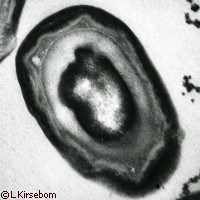Discovery of mycobacteria spore formation sheds light on tuberculosis
Scientists in Sweden have discovered that a type of mycobacteria, the genus responsible for causing tuberculosis, leprosy and Buruli ulcer, owes its success in part to its ability to form spores during its latent state. The findings, reported in the journal Proceedings of the National Academy of Sciences, have major implications for the prevention of these serious diseases. Mycobacterium tuberculosis (Mtb) is very widespread in the human population and is found in an estimated one third of all people worldwide. Every year, approximately 10 million new cases of tuberculosis are diagnosed, and it causes between 2 million and 3 million deaths. But in most cases, people do not show any symptoms of the disease because Mtb goes through very long periods of latency. 'This means that the disease can break out much later, even decades after the initial infection,' explained lead investigator Leif Kirsebom of Sweden's Uppsala University. The way mycobacteria opportunistically transition between latent and active forms has been the focus of intensive research; having a clearer picture would go a long way in helping scientists to figure out ways of preventing mycobacterial infections. One way that bacteria can successfully 'hibernate' is by generating spores, which are tough, stable and can remain inactive for years. The Uppsala research team were investigating something entirely different when they made some intriguing observations about one type of mycobacteria, which led to a change in the direction of their research. They decided to investigate the life cycle of Mycobacterium marinum (Mm), which causes tuberculosis-like diseases in fish and frogs. 'We followed the changes in cell size and DNA content distributions of Mm cultures on plates through the full life cycle - from their inoculation into fresh medium, through exponential growth, and up to stationary phase - by using flow cytometry and microscopy,' the authors explain. Flow cytometry is used to count and examine microscopic particles that are suspended in fluid. They observed that during stationary phase, the Mm cultures contained a large number of very small cells in addition to the bigger ones; scanning electron microscopy (SEM) confirmed the presence of many uniform, small-sized shiny particles. To confirm that these particles were indeed spores, they used differential spore staining (to which spores respond in a particular way) and a heat-tolerance test to see how the particles responded to stress (spores are highly tolerant of physical and chemical stresses). They also used bioinformatics to see whether the particles had the genetic apparatus necessary for entry into and exit from the spore state. Contrary to textbook definitions of mycobacterial behaviour, the researchers confirmed that Mm is indeed capable of forming spores. 'If sporulation turns out to be a common mechanism used by mycobacteria in response to environmental conditions,' the study concludes, 'we speculate that it might well be one of the means by which it attains dormancy within the host. This finding opens up a hitherto unknown area of mycobacteria development, and might provide new tools to combat mycobacterial diseases such as tuberculosis by preventing the disease itself and/or its transmission by spores.' The researchers also speculate that because Mm is so closely related to the agent that causes Buruli ulcer, one of the fastest-emerging mycobacterial diseases, the findings may also have implications for its prevention. 'This opens a completely new chapter in mycobacteriology,' Dr Kirsebom commented. 'Now we can perhaps understand how mycobacteria ''hibernate'' and cause latent infections.' In addition to causing tuberculosis, leprosy and Buruli ulcer, mycobacteria are known to cause Johne's disease in cattle and could be involved in Crohn's disease in humans. The discovery that mycobacteria can form spores provides invaluable insights into our understanding of how they enter and emerge from their latent state, and how they spread.
Countries
Sweden



